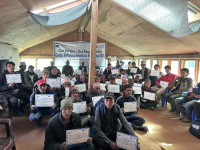Culture & Lifestyle
In Jhochhen, an age-old culture is slowly fading away
Even though many core Newa neighbourhoods celebrate Gathanmugah, at Jhochhen and Basantapur, the tradition has ceased to exist for years now, say locals.
Srizu Bajracharya
For 74-year-old Kamala Bajracharya, everything in Jhochhen-Basantapur of Ward No. 23 has changed unbelievably. As she looks outside her window that faces the Nautalle Durbar and the big open Basantapur dabali, she sighs deeply remembering the old days: when Jhochhen was not filled with restaurants and coffee shops, but small pasals. A time when even smaller festivals brought people together.
With Gathanmugah, a Newa festival celebrated to ward off evil in the Nepali month of Shrawan here, the change is even more distinct. “I think it’s been about 10 years that we haven’t celebrated the festival here. No one makes the big narkat, an effigy of a demon made with green reeds and straw ropes to place it at the crossroad,” she says. “Now everything has changed. Only a few familiar faces are living in the neighbourhood, and no procession follows the festival.” The festival this year falls on Sunday, July 19.
In the last few decades, Jhochhen and Basantapur have undergone rapid changes. In the 1970s, the place found its new name Freak Street with the arrival of hippies and with it, the area became more commercial. In later years, many families voluntarily moved out of the neighbourhood, renting their houses to tenants to open their own shops and offices in the place. In the last decade, Jhochhen has also seen a boom of dozens of restaurants and eateries. The commercialisation of the locality has dwindled the communal vibe, and many celebrations, like Gathanmugah, no longer see local engagement and sharing.
According to Ward-23 Chairperson Macharaja Maharjan, about 40 percent of local families have moved out of the core Jhochhen and Basantapur area. And as many as 50 to 60 restaurants and hotels have sprung up in these years. “We don’t have specific data to show the numbers, but we can make out the percentage based on the elderly allowance that we give away. Many families come from Sanepa, Bhaktapur and places around the Valley,” says Maharjan. “But the change is quite visible with how things have been around here,” he says.
In the age-old days, during Gathanmugah, families would clean their houses and paint the floors with earth for purification. They would bathe and make arrangements for bau, sacramental offerings to the evil force in the evening. Some locals, mainly Manandhar and Jyapus, would bring bamboo sticks and straws early in the morning to make the evil effigy of Ghantakarna. This demon, according to long tales, made life difficult for people. After that, children would hang voodoo dolls on the effigy.
Bajracharya still remembers running to the crossroad to hang the voodoo doll filled with masalas that her grandmother would make for her when she was a child. “Many children and men also used to go from house to house to ask for jagaat, donation for the man impersonating as the demon,” she says.
The man appointed as Ghantakarna would have foul words written all over him, with mostly black colour covering his skin. “The person usually used to be someone from a "low caste" family or an outcast, and he would carry a dahi bhegah (an earthen pot) around the locality to get money. And by the end of the evening, he would be pulled with the effigy to the Bishnumati river. It was an iteration to ward off evil,” says Maharjan. During the procession, people would shout out of their windows and doors, "Aaju jaya haaa", which translates to "hail the protector.”
“In the later years, the man impersonating the demon would run off midway as we would carry the narkat out to Bishnumati river,” says 63-year-old Prakash Shakya, another local of Jhochhen. The demon effigy used to be placed at every crossroad of Newa localities. And by the end of the evening, it used to be burnt and hurled away at the river.
“But it’s been about 10 to 5 years that we haven’t had an elaborate celebration. Now everyone is busy, and there’s not much participation,” he says. At Jhochhen, after the procession, locals used to gather at the courtyard of Sitaram High School, where now Shiva Arcade stands.
Maharjan also believes the festival has seen a change because many people are now realising the discriminating side of the festival. “I think we are at an age where we realise that it’s not right to do a procession by demeaning a person or caste groups. And so, in many places, the reiteration of ghantakarna has stopped,” he says. According to an article about Gathanmugah in ‘Hamro Chadparva’ by Punyaratna Bajracharya, "low caste" people were called “chandaal” or evil. And so they were the ones who would be called to represent the demon.

Gathanmugah, however, is one of the oldest festivals of the Valley, one which also marks the end of the ropai season and onset of a series of festivals. It’s also similar to Himalayan festivals like Dumje, Tiji, Manirimdhu which are celebrated to ward off evil energy. Punyaratna Bajracharya also writes that the festival must have started to make people aware of maintaining proper hygiene and cleanliness in a season of breeding insects and diseases, a time when people believed in the supernatural.
“It was a time when people were not educated, and the festival was a means to make them aware of humanity, and make them more civilised. It was a mechanism to give them a sense of control,” says Subarna Shakya, a cultural expert and social worker. “But when continuing such a culture one must understand why a festival came to be than just blindly following it as tradition,” he says.
Twenty-five years back, Shakya along with his peers had voiced against the defamatory ritual of having a "low caste" person enact as the demon to set him down the river. “It’s good that that tradition stopped in Jhochhen, but please be mindful, in many places, this still continues. I remember having a brawl with the community people at the time because they believed that tradition should continue as it was an age-old practice,” he says.
But traditions over time change and should change, says Shakya who used to live in Om Bahal. “Of course we should continue our culture and tradition, but we must also be able to question our traditions,” he says.
The origin of the Gathanmugah festival has many stories to it: one is of the demon who wore bells in their ears. The story goes that the beast stole children and created havoc for people, and so the frogs informed humans who killed the demon and tied him at the crossroad, later to throw the beast at the river. In later years, this was enacted to show people the victory of good over evil, to strengthen people’s spirit, says Maharjan.
Most tales, however, seem to support a social structure which in the process of practising power forms a systematic arrangement of oppression. And in time they begin to look like a tradition that must continue. “But here’s the thing, myths are not history. It’s important to continue our culture and tradition but not to the extent that we don’t see the wrong in it. After all, like all things, these are meant to change with time,” says Shakya.
Eighty-four-year-old Shakya believes that the end of the defamatory side to the festival in Jhochhen is a sign of a progressing society, however, to completely disown the festival would be wrong.
“There were so many good parts of the festival like how the community people came together to clean the locality and feast together, but if we are to forget everything, our culture might die just like that,” he says.
But at Jhochhen, the communal tradition is almost wholly discarded and rather inconspicuously. No one really knows when the tradition really stopped while many other Newa neighbourhoods still celebrate the festival. Some locals believe the festival stopped being celebrated after the 2015 earthquake while some believe it was much before that.
The crossroad of Jhochhen and Basantapur has been without a figurine of the demon for years. And young children of the neighbourhood have only heard of the dolls that used to be hung on the figurine. Nor has anyone ever come to discuss why the tradition stopped. Some believe it was to get rid of the nuisance the festival brought while some think it’s because of modernisation and the busy-ness of modern life.
Bajracharya too hasn’t celebrated the festival for years as she is getting old, and her family lives outside of Jhochhen. “I can’t pin the mantra paper to the door by myself, so I don’t do it anymore,” she says. “And there is no communal celebration of the locality to be a part of.”
But festivals like Gathanmugah have a larger significance because it is supposed to bring together people more organically, by doing something together as a community. “So, it’s sad that these cultures are slowly withering to the times we are living in. It would have been nice to see the community come together,” says Bajracharya.




 15.12°C Kathmandu
15.12°C Kathmandu















